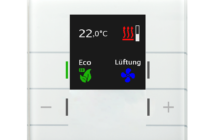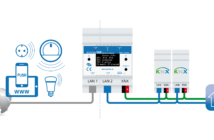Ich bin gefragt worden, wie die Steuerung von Sonos mit Misterhouse
c) ein InfoTerminal Touch oder sonst welche Schalter die mit dem Gruppenadressen definiert (auch wenn davon erst einmal nur ein kleiner Teil benutzt wird:)
EIB1, 7/0/0, Sonos_AlleAus, gSonos|gSonos_Command,
EIB1, 7/0/1, Sonos_Play, gSonos|gSonos_Command,
EIB1, 7/0/2, Sonos_Stop, gSonos|gSonos_Command,
EIB1, 7/0/3, Sonos_Rewind, gSonos|gSonos_Command,
EIB1, 7/0/4, Sonos_Forward, gSonos|gSonos_Command,
EIB1, 7/0/5, Sonos_Lauter, gSonos|gSonos_Command,
EIB1, 7/0/6, Sonos_Leiser, gSonos|gSonos_Command,
EIB1, 7/0/7, Sonos_Mute, gSonos|gSonos_Command,
EIB1, 7/0/40, Sonos_Modeumschaltung, gSonos|gSonos_Command,
EIB1, 7/0/41, Sonos_NormalMode, gSonos|gSonos_Command,
EIB1, 7/0/42, Sonos_Repeat, gSonos|gSonos_Command,
EIB1, 7/0/43, Sonos_Shuffle, gSonos|gSonos_Command,
EIB1, 7/0/44, Sonos_ShuffleRepeat, gSonos|gSonos_Command,
EIB1, 7/0/61, Sonos_Radio1, gSonos|gSonos_Source,
EIB1, 7/0/62, Sonos_Radio2, gSonos|gSonos_Source,
EIB1, 7/0/63, Sonos_Radio3, gSonos|gSonos_Source,
EIB1, 7/0/64, Sonos_Radio4, gSonos|gSonos_Source,
EIB1, 7/0/71, Sonos_Playlist1, gSonos|gSonos_Source,
EIB1, 7/0/72, Sonos_Playlist2, gSonos|gSonos_Source,
EIB1, 7/0/73, Sonos_Playlist3, gSonos|gSonos_Source,
EIB1, 7/0/74, Sonos_Playlist4, gSonos|gSonos_Source,
EIB1, 7/0/81, Sonos_Extern1, gSonos|gSonos_Source,
EIB1, 7/0/82, Sonos_Extern2, gSonos|gSonos_Source,
EIB1, 7/0/83, Sonos_Extern3, gSonos|gSonos_Source,
EIB1, 7/0/84, Sonos_Extern4, gSonos|gSonos_Source,
EIB1, 7/0/91, Sonos_Zone1, gSonos|gSonos_Player,
EIB1, 7/0/92, Sonos_Zone2, gSonos|gSonos_Player,
EIB1, 7/0/93, Sonos_Zone3, gSonos|gSonos_Player,
EIB1, 7/0/94, Sonos_Zone4, gSonos|gSonos_Player,
EIB1, 7/0/96, Sonos_Zone1trennen, gSonos|gSonos_Zone1,
EIB1, 7/0/97, Sonos_Zone2trennen, gSonos|gSonos_Zone2,
EIB1, 7/0/98, Sonos_Zone3trennen, gSonos|gSonos_Zone3,
EIB1, 7/0/99, Sonos_Zone4trennen, gSonos|gSonos_Zone4,
EIB15, 7/0/100, Sonos_Playername, gSonos,
EIB1, 7/0/101, Sonos_Player1, gSonos|gSonos_Player,
EIB1, 7/0/102, Sonos_Player2, gSonos|gSonos_Player,
EIB1, 7/0/103, Sonos_Player3, gSonos|gSonos_Player,
EIB1, 7/0/104, Sonos_Player4, gSonos|gSonos_Player,
EIB1, 7/0/105, Sonos_Player5, gSonos|gSonos_Player,
EIB1, 7/0/106, Sonos_Player6, gSonos|gSonos_Player,
EIB1, 7/0/107, Sonos_Player7, gSonos|gSonos_Player,
EIB1, 7/0/108, Sonos_Player8, gSonos|gSonos_Player,
EIB1, 7/0/109, Sonos_Player9, gSonos|gSonos_Player,
EIB1, 7/0/111, Sonos_Zone1Player1, gSonos|gSonos_Zone1,
EIB1, 7/0/112, Sonos_Zone1Player2, gSonos|gSonos_Zone1,
EIB1, 7/0/113, Sonos_Zone1Player3, gSonos|gSonos_Zone1,
EIB1, 7/0/114, Sonos_Zone1Player4, gSonos|gSonos_Zone1,
EIB1, 7/0/115, Sonos_Zone1Player5, gSonos|gSonos_Zone1,
EIB1, 7/0/116, Sonos_Zone1Player6, gSonos|gSonos_Zone1,
EIB1, 7/0/117, Sonos_Zone1Player7, gSonos|gSonos_Zone1,
EIB1, 7/0/118, Sonos_Zone1Player8, gSonos|gSonos_Zone1,
EIB1, 7/0/119, Sonos_Zone1Player9, gSonos|gSonos_Zone1,
usw.
Diese Misterhouse dann ein paar Vorbelegungen der Art:
$SonosZoneIP[0] = "192.168.0.101"; # Wohnzimmer
$SonosZoneIP[1] = "192.168.0.102"; # Kueche
$SonosZoneIP[2] = "192.168.0.103"; # Garten
$SonosZoneIP[3] = "192.168.0.104"; # Schlafzimmer
$SonosZoneIP[4] = "192.168.0.105"; # Bad
$SonosPlayername[0] = "Wohnen";
$SonosPlayername[1] = "Kueche";
$SonosPlayername[2] = "Garten";
$SonosPlayername[3] = "Schlafen";
$SonosPlayername[4] = "Bad";
$SonosExternalInputDevice[0] = "RINCON_000E5123456001400";
$SonosExternalInputTitle[0] = "Satellitenempfänger";
#Radio Wuppertal 107.4
$SonosRadioStation[0] = "x-rincon-mp3radio://www.vtuner.com/vtunerweb/asp/StatLaunchMP3.asp?id=21906&link=1";
$SonosRadioStationID[0] = 27;
$SonosRadioStationName[0] = "Radio Wuppertal 107.4";
#WDR 1 Live 103.7 (Top 40 Popmusik)
$SonosRadioStation[1] = "x-sonosapi-stream:s100198?sid=254";
$SonosRadioStationID[1] = 2;
$SonosRadioStationName[1] = "WDR 1 Live 103.7 (Top 40 Popmusik)";
#Playlist Top 10
$SonosPlaylist[0] = "/mnt/Music/Top10";
usw.
und dann die mit den jeweiligen Gruppenadressen verknüpften Aktion wie z.B.:
[HIGHLIGHT=PERL]
if (state_now $Sonos_AlleAus) {
for($i=1;$i<$iAnzPlayer+1;$i++){
Sonos_Pause($i-1);
}
}
if (state_now $Sonos_Radio1) {
Sonos_Radio($SonosPlayerNR, 0);
}
if (state_now $Sonos_Radio2) {
Sonos_Radio($SonosPlayerNR, 1);
}
if (state_now $Sonos_Playlist1) {
Sonos_ClearQueue($SonosPlayerNR);
Sonos_SetQueue($SonosPlayerNR, 0);
@SonosFileList = <$SonosPlaylist[0]/*.mp3>;
$i=0;
foreach $SonosFileName (@SonosFileList) {
$i=$i+1;
my $SonosFileName2 = „x-file-cifs://QNAP239-1/Music/Top10“.substr($SonosFileName,length($SonosPlaylist[0]));
Sonos_AddToQueue($SonosPlayerNR, $SonosFileName2);
if($i==1) {
Sonos_Play($SonosPlayerNR);
}
}
}
if (state_now $Sonos_Rewind) {
Sonos_Rewind($SonosPlayerNR);
}
if (state_now $Sonos_Play) {
Sonos_Play($SonosPlayerNR);
}
if (state_now $Sonos_Stop) {
Sonos_Pause($SonosPlayerNR);
}
if (state_now $Sonos_Forward) {
Sonos_Next($SonosPlayerNR);
}
if (state_now $Sonos_Modeumschaltung) {
$SonosModeNR += 1;
if($SonosModeNR==1) {
set $Sonos_NormalMode OFF;
set $Sonos_Repeat ON;
}
elsif($SonosModeNR==2) {
set $Sonos_Repeat OFF;
set $Sonos_Shuffle ON;
}
elsif($SonosModeNR==3) {
set $Sonos_Shuffle OFF;
set $Sonos_ShuffleRepeat ON;
}
else {
$SonosModeNR = 0;
set $Sonos_ShuffleRepeat OFF;
set $Sonos_NormalMode ON;
}
Sonos_PlayMode($SonosPlayerNR, $SonosMode[$SonosModeNR]);
}
if (state_now $Sonos_Lauter) {
for($i=1;$i<6;$i++){
Sonos_Volume($SonosPlayerNR, $SonosVolume+$i);
select(undef, undef, undef, 0.4); # sleep 0.4s between every step
}
$SonosVolume += $i
}
usw.[/HIGHLIGHT]
Die Aktionen rufen dann also Unterprogramme für die einzelnen Funktionen auf, denen die Nummer des zu steuernden Players und ggf. weitere benötigte Werte (im Fall der Lautstärkeänderung der Wert für die Lautstärke, der zu spielende Radiosender, etc.) übergeben wird.
In den einzelnen Unterprogrammen wird dann nur der zu sendende String zusammengebaut und per IO::Socket::INET ins LAN gesendet.
Das sieht dann z.B. so aus:
[HIGHLIGHT=PERL]
sub Sonos_Volume {
my ($_player,$_volume) = @_;
my $_SonosIP =$SonosZoneIP[$_player];
my $_StringLength = 321+length($_volume);
my $_Sonos_content=’POST /MediaRenderer/RenderingControl/Control HTTP/1.1
CONNECTION: close
ACCEPT-ENCODING: gzip
HOST: ‚.$_SonosIP.‘:1400
CONTENT-LENGTH: ‚.$_StringLength.‘
CONTENT-TYPE: text/xml; charset=“utf-8″
SOAPACTION: „urn:schemas-upnp-org:service:RenderingControl:1#SetVolume“
<u:SetVolume xmlns:u=“urn:schemas-upnp-org:service:RenderingControl:1″>0Master‘.$_volume.“;
my $Sonos_socket = new IO::Socket::INET (PeerAddr => $_SonosIP, PeerPort => $SonosPort, Proto => ‚tcp‘,);
die „ERROR: Unable to connect to Sonos Player $_SonosIP $!\n“ unless $Sonos_socket;
print $Sonos_socket $_Sonos_content;
close($Sonos_socket);
}
##############################################
sub Sonos_PlayMode {
my ($_player,$_playmode) = @_;
my $_SonosIP =$SonosZoneIP[$_player];
my $_StringLength = 291+length($_playmode);
my $_Sonos_content=’POST /MediaRenderer/AVTransport/Control HTTP/1.1
CONNECTION: close
ACCEPT-ENCODING: gzip
HOST: ‚.$_SonosIP.‘:1400
CONTENT-LENGTH: ‚.$_StringLength.‘
CONTENT-TYPE: text/xml; charset=“utf-8″
SOAPACTION: „urn:schemas-upnp-org:service:AVTransport:1#SetPlayMode“
<u:SetPlayMode xmlns:u=“urn:schemas-upnp-org:service:AVTransport:1″>0′.$_playmode.“;
my $Sonos_socket = new IO::Socket::INET (PeerAddr => $_SonosIP, PeerPort => $SonosPort, Proto => ‚tcp‘,);
die „ERROR: Unable to connect to Sonos Player $_SonosIP $!\n“ unless $Sonos_socket;
print $Sonos_socket $_Sonos_content;
close($Sonos_socket);
}
##############################################
sub Sonos_Radio {
my ($_player,$_station) = @_;
my $_SonosIP =$SonosZoneIP[$_player];
my $_SonosRadioStation = encode_entities($SonosRadioStation[$_station]);
my $_SonosRadioStationID = $SonosRadioStationID[$_station];
my $_SonosRadioStationName = encode_entities($SonosRadioStationName[$_station]);
my $_StringLength = 958+length($_SonosRadioStation)+length($_SonosRadioStationID)+length($_SonosRadioStationName);
my $_Sonos_content=’POST /MediaRenderer/AVTransport/Control HTTP/1.1
CONNECTION: close
HOST: ‚.$_SonosIP.‘:1400
CONTENT-LENGTH: ‚.$_StringLength.‘
CONTENT-TYPE: text/xml; charset=“utf-8″
SOAPACTION: „urn:schemas-upnp-org:service:AVTransport:1#SetAVTransportURI“
<u:SetAVTransportURI xmlns:u=“urn:schemas-upnp-org:service:AVTransport:1″>0′.$_SonosRadioStation.“.$_SonosRadioStationName.’object.item.audioItem.audioBroadcastSA_RINCON65031_‘;
my $Sonos_socket = new IO::Socket::INET (PeerAddr => $_SonosIP, PeerPort => $SonosPort, Proto => ‚tcp‘,);
die „ERROR: Unable to connect to Sonos Player $_SonosIP $!\n“ unless $Sonos_socket;
print $Sonos_socket $_Sonos_content;
close($Sonos_socket);
Sonos_Play($_player);
}
##############################################
sub Sonos_ClearQueue {
my ($_player) = @_;
my $_SonosIP =$SonosZoneIP[$_player];
my $_Sonos_content=’POST /MediaRenderer/AVTransport/Control HTTP/1.1
CONNECTION: close
HOST: ‚.$_SonosIP.‘:1400
CONTENT-LENGTH: 290
CONTENT-TYPE: text/xml; charset=“utf-8″
SOAPACTION: „urn:schemas-upnp-org:service:AVTransport:1#RemoveAllTracksFromQueue“
<u:RemoveAllTracksFromQueue xmlns:u=“urn:schemas-upnp-org:service:AVTransport:1″>0′;
my $Sonos_socket = new IO::Socket::INET (PeerAddr => $_SonosIP, PeerPort => $SonosPort, Proto => ‚tcp‘,);
die „ERROR: Unable to connect to Sonos Player $_SonosIP $!\n“ unless $Sonos_socket;
print $Sonos_socket $_Sonos_content;
close($Sonos_socket);
}
##############################################
sub Sonos_AddToQueue {
my ($_player,$_file) = @_;
my $_SonosIP =$SonosZoneIP[$_player];
my $_SonosFileName = encode_entities($_file);
my $_StringLength = 438+length($_SonosFileName);
my $_Sonos_content=’POST /MediaRenderer/AVTransport/Control HTTP/1.1
CONNECTION: close
HOST: ‚.$_SonosIP.‘:1400
CONTENT-LENGTH: ‚.$_StringLength.‘
CONTENT-TYPE: text/xml; charset=“utf-8″
SOAPACTION: „urn:schemas-upnp-org:service:AVTransport:1#AddURIToQueue“
<u:AddURIToQueue xmlns:u=“urn:schemas-upnp-org:service:AVTransport:1″>0′.$_SonosFileName.’01‘;
my $Sonos_socket = new IO::Socket::INET (PeerAddr => $_SonosIP, PeerPort => $SonosPort, Proto => ‚tcp‘,);
die „ERROR: Unable to connect to Sonos Player $_SonosIP $!\n“ unless $Sonos_socket;
print $Sonos_socket $_Sonos_content;
close($Sonos_socket);
}
##############################################
usw.[/HIGHLIGHT]


